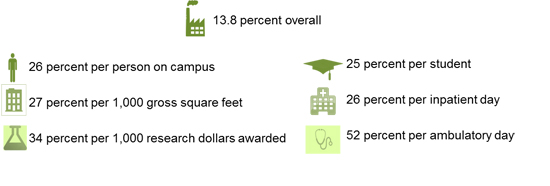Vanderbilt’s Sustainability and Environmental Management Office has released an updated inventory of the campus’s greenhouse gas (GHG) emissions for the calendar years 2005-2012 to mark Campus Sustainability Day, Oct. 23. This inventory illustrates Vanderbilt’s current carbon footprint and provides trending information over the past eight years.
Overall GHG emissions from the campus and medical center decreased by 19 percent from an all-time high reached in 2008, and by 14 percent from 2005 to 2012, even though Vanderbilt has seen significant growth in square footage, staff, students and research dollars since 2008. When growth is taken into account, GHG reductions are down more than 25 percent.

Quantifying GHG emissions over time allows the Vanderbilt community to better understand its unique impact on the environment now and in the past and to determine the most effective improvement strategies for implementation in the future.
One major improvement already in the works is the conversion of Vanderbilt’s coal- and natural gas-fueled co-generation power plant to all natural gas. “The co-generation facility conversion to all natural gas improves the efficiency of our plant and will also significantly reduce our GHG emissions and other types of air emissions in the future,” said Mark Petty, assistant vice chancellor of plant operations.

“These improvements are the result of intensive energy efficiency efforts by Plant Operations, Campus Planning and Construction and VUMC Facilities and Construction,” said Andrea George, director of SEMO. “We also hope that faculty, staff and students are doing their part to reduce our GHG emissions by turning off lights and powering down computers when not in use, reasonably adjusting thermostats throughout the year, recycling, and taking advantage of mass transit options to get to and from campus.”
Vanderbilt emits GHGs primarily through building utility consumption but also by the commuting behaviors of the university’s faculty, staff and students and the disposal of waste generated by Vanderbilt. A 60 percent increase in Vanderbilt’s recycling volume in 2012 resulted in a significant improvement in GHG emissions associated with waste disposal: a drop of 66 percent in academic and research areas, and 31 percent in patient care areas.
SEMO compiled the extensive GHG emissions inventory, which is available in its entirety on the SustainVU website.
For more information about Vanderbilt’s sustainability program, visit SustainVU, become a fan of the SustainVU Facebook page or contact SEMO at SustainVU@vanderbilt.edu or 322-9022.
Contact: SustainVU, (615) 322-9022
SustainVU@vanderbilt.edu